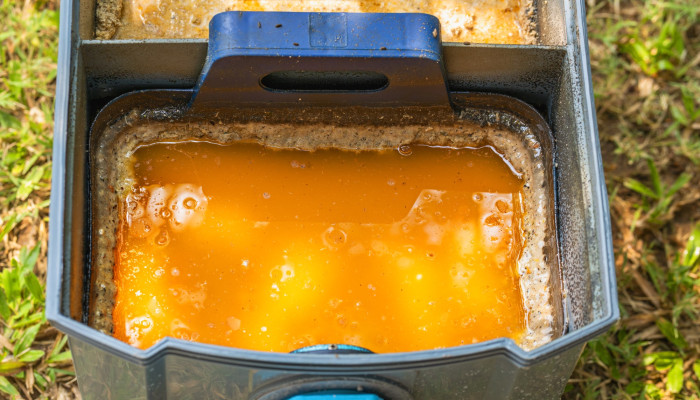As the heart of the plumbing system of a busy restaurant, it’s necessary to keep a grease trap in good condition. Grease traps are complex devices that handle tons of dirty wastewater every day. The device prevents fats, oils, and grease (FOG) from entering the municipal sewer system, reducing the risk of clogs, backups, and environmental disasters. For all these reasons, regular maintenance and occasional grease trap replacement are crucial to keeping your kitchen running smoothly and safely.
If you’re running a busy commercial kitchen, you need to look for a few signs to determine the requirement for a grease trap replacement. Slow-draining sinks, foul odors, and excessive FOG and sludge buildup inside the device are a few of those. If you notice any of these symptoms in your kitchen, it’s time to consider a replacement!
Replacing a grease trap can seem like a complex task, but it’s important to remember that it’s a necessary one. Let’s explore the process of replacing your grease trap. We shall also cover the benefits of a new grease trap, including improved kitchen hygiene, compliance with local regulations, and the extended lifespan of your kitchen equipment.

Signs that show Its time for Grease Trap Replacement
Maintaining a functional grease trap is essential for the safe and efficient operation of a commercial kitchen. However, like any other piece of equipment, grease traps can wear out and become less effective over time. Here are some signs that your grease trap may need replacement:
Slow-draining sinks and backups: Are your sinks taking longer than usual to drain? Or are you experiencing backups in your plumbing system? Slow-draining sinks and sewer backups indicate a clogged or failing grease trap and you need immediate grease trap maintenance or replacement.
Foul odors emanating from the drain: When grease traps are not functioning properly, they can cause unpleasant smells to waft through your kitchen. If you notice any unusual odors, contact your plumber ASAP to investigate the cause.
Excessive grease buildup in the trap: If you notice that your grease trap is filling up more quickly than usual or that it’s difficult to remove the grease, it could mean that your trap is at the end of its lifespan.
Visual inspection of the trap reveals cracks, corrosion, or damage: Sometimes physical damages such as cracks or corrosions are clearly visible to your grease trap. Such cracks or corrosion is a sure sign that it’s time to replace your grease trap.
It’s essential to act swiftly upon noticing any of the signs mentioned above to prevent any further plumbing problems or violations of local health codes. Consulting with a professional plumber or grease trap specialist is recommended to assess whether your current trap needs to be replaced and to determine the appropriate size and type of trap for your specific kitchen.
How Grease Trap Replacement is done
First of all, you must understand that Grease trap replacement is not a DIY project. The device consists of several complex components and requires an expert to install it. After determining that your grease trap needs to be replaced, it’s best to seek help from a professional grease trap company to ensure a smooth and successful replacement.
Here are the key steps in the process:
Preparing for the replacement process: Before jumping into the replacement process, there are a few precautions that are essential. Be sure to turn off the water supply to the grease trap and disconnect the pipes that connect it to the plumbing system. This will help prevent any further damage to your plumbing system.
Removing the old grease trap and disposing of it properly: Once the broken grease trap is disconnected from the kitchen sink and the plumbing system, an expert need to remove it carefully and dispose of the stored materials properly. The removed food sludge and FOG will be taken to a nearby government-authorized disposal ground.
Choosing a new grease trap that is the right size and type for your kitchen’s needs: Choosing the appropriate grease trap for your establishment is very important. You must consider factors such as the size of your kitchen, the amount of FOG produced, and local regulations when selecting a new trap. Experts at GreasyMikes can help you with these by letting you know about all the pros and cons of different types of grease traps.
Installing the new grease trap and ensuring proper connections: This is the most crucial step of grease trap replacement. As mentioned earlier, grease traps are really complicated devices with multiple components such as valves, baffles t, etc. It’s always best to let a grease trap expert assemble this to make sure all the components are getting installed accordingly as they should for the grease trap to actually work.
Testing the new grease trap to ensure it is functioning properly: Finally, once the new trap is installed, it’s important to test it to ensure that it’s functioning properly. This will help you avoid any further issues with your plumbing system.
By following these steps and working with a professional plumber or grease trap specialist such as the GreasyMikes, you can ensure that your new grease trap is installed correctly and is functioning at its best.

